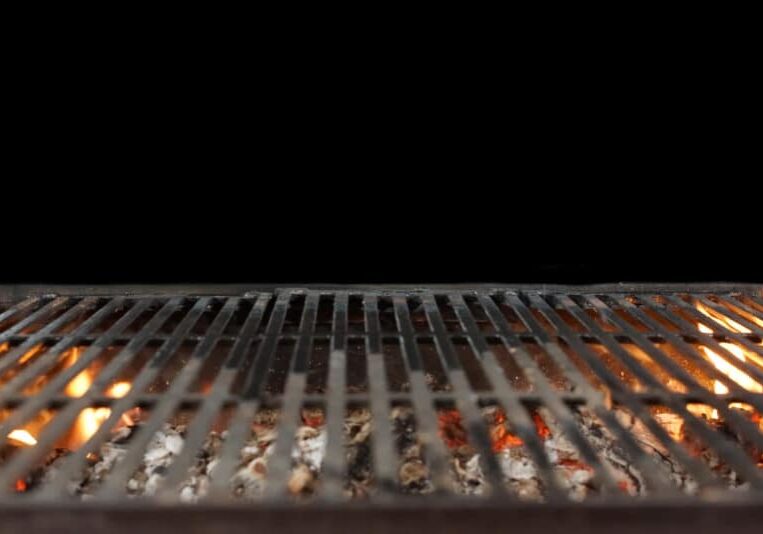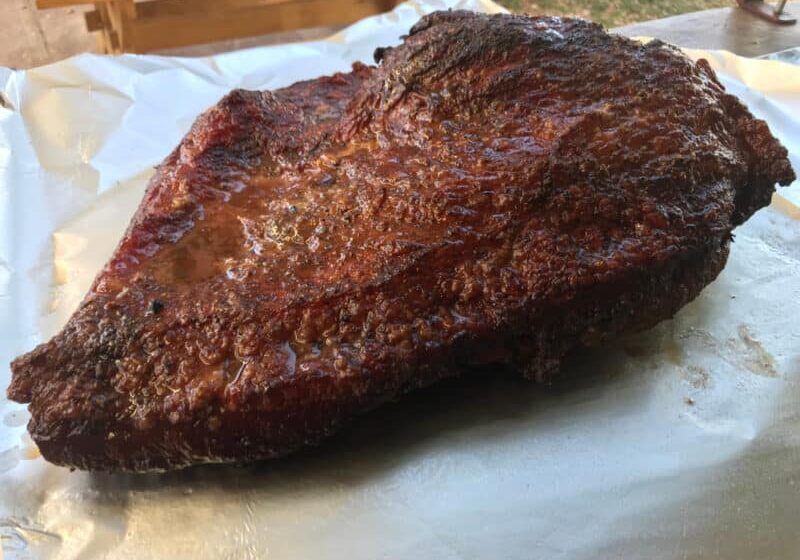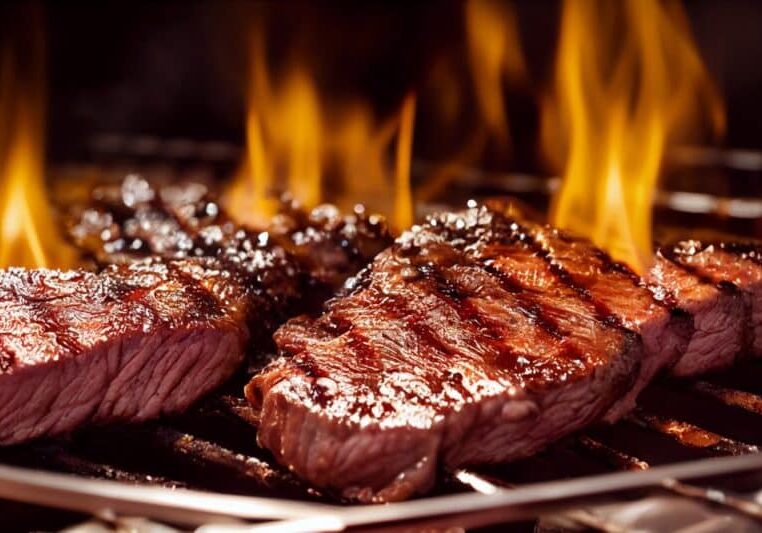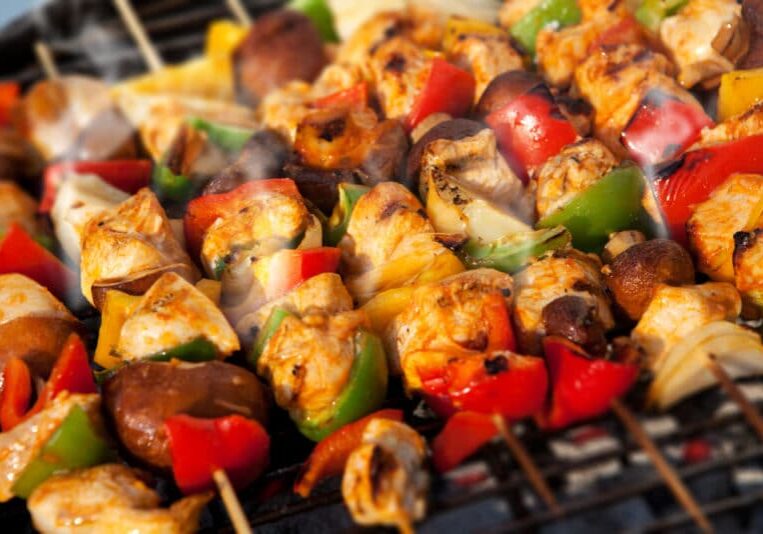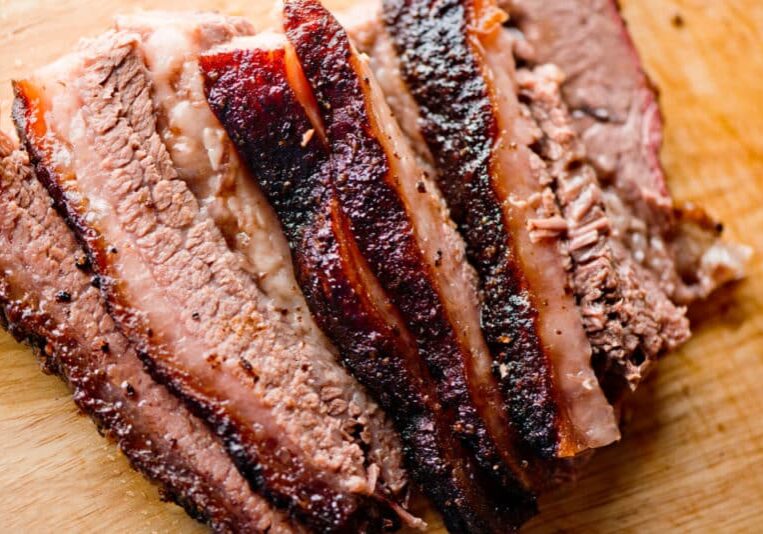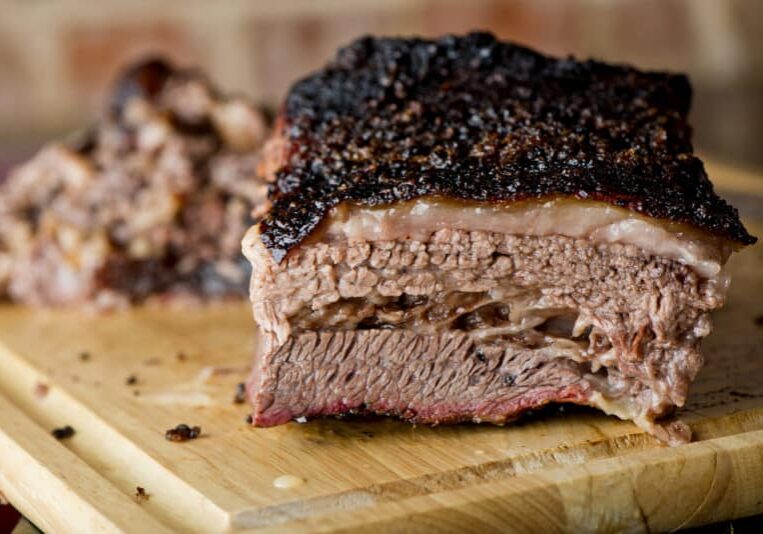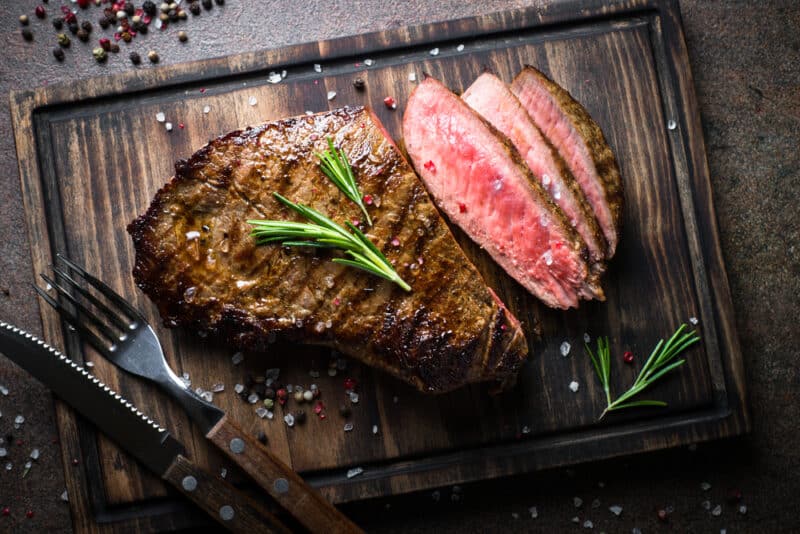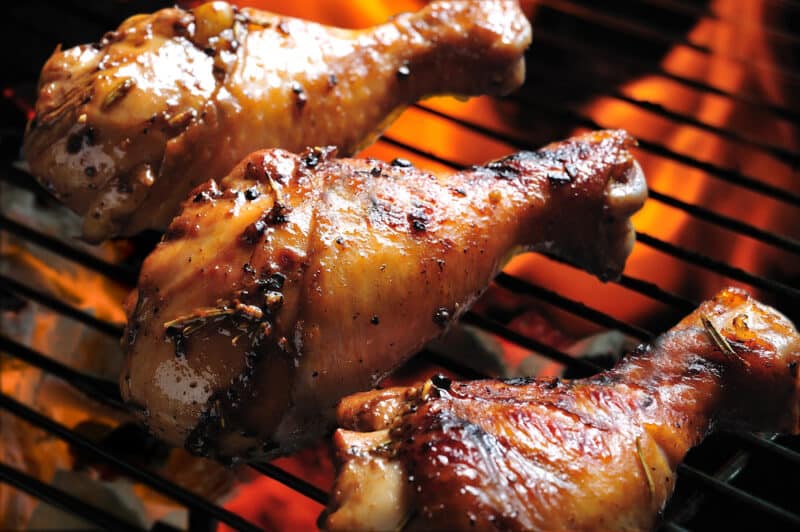How to Rest a Brisket
TheGrillingMaster.com is reader-supported. If you buy something using the links on our site, we might earn an affiliate commission at no added cost to you. This helps us pay our staff to keep making awesome content for you!
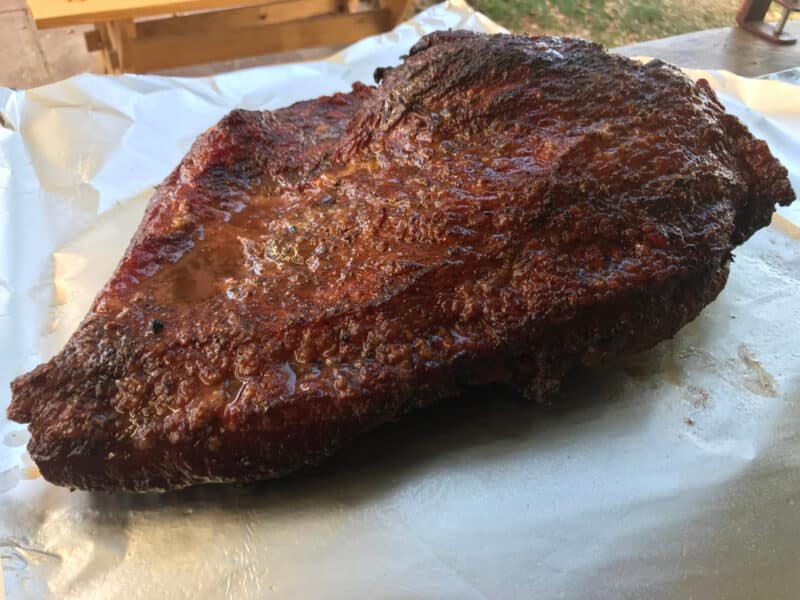
How to Rest Brisket
Understanding how to rest a brisket is crucial for achieving a moist and succulent result, whether it’s cooked in an oven or a smoker. This guide provides comprehensive information on the importance of resting a brisket before serving it and what happens during the resting phase.
There are different options and opinions about how to rest a smoked brisket and for how long. In this article, we’ll discuss the different options, so you can make informed decisions about the methods that will work best for you.
Pitmasters understand the significance of allowing the meat to rest before serving, despite the temptation to indulge in the mouth-watering aroma straight off the grill. This guide aims to share all the necessary knowledge for achieving a tender and flavorful beef brisket.
One thing is certain, you better be prepared for the long haul and remember to include the resting time when you intend to smoke a brisket. You should already know that it will take up to 12 hours to cook, followed by 1 to 2 hours of resting.
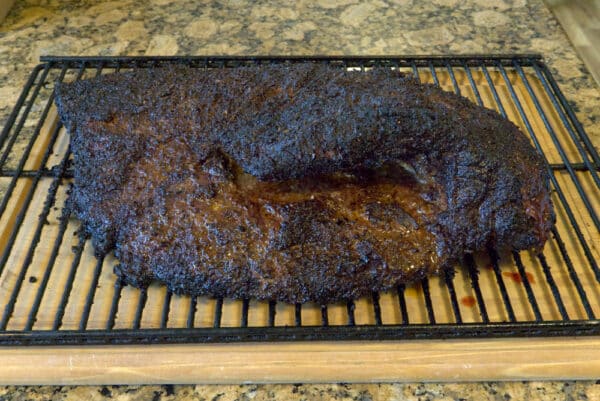
Resting a brisket at room temperature
Resting Brisket vs. Holding Brisket
Before we get into how to rest a brisket, we need to understand the difference between holding and resting. Many people interchange these two terms, but there are significant differences.
Resting Brisket
Resting a brisket is a short-term process that improves the quality of the meat by allowing it to reabsorb juices.
Holding Brisket
Holding a brisket is a longer-term process done for the purpose of keeping the meat warm and ready to serve. This is typically done for catering or large-scale events where the brisket needs to be kept warm and ready to serve over a longer period of time.
Here’s an example: If I start smoking a large-packer brisket at 8 am, it should be done by 10 pm.
I will then either wrap the brisket in butcher paper or aluminum foil or leave it unwrapped to rest. However, by the end of the resting stage, it will be about midnight, so how will I keep the brisket juicy and tender to serve it for lunch the following day?
This is where the holding comes in. After resting, I’ll wrap the brisket thoroughly in kitchen towels and transfer it to a warmed insulated cooler or a holding oven (Cambro) at a regulated temperature until it is time to serve it for lunch the next day.
The USDA recommends keeping beef at a minimum temperature of 145 °F. If the internal temperature of the meat drops below this, it enters the danger zone and then there is an increased risk of food poisoning. The only other safe option is to keep the brisket at below 40 °F and reheat it the next day.
Factors to Consider When Resting a Brisket
Finding the perfect balance between tenderness and flavor is the ultimate goal of resting a smoked brisket. The following factors should be considered if you want to reach your goal:
- The size of the brisket
- The temperature at which it was smoked
- The internal temperature
- When to pull the brisket for resting, consider the carry-over cooking that will occur
What does “Resting” a Brisket Mean?
Resting meat is letting it sit at room temperature after cooking, which may seem straightforward. However, there’s more to it than meets the eye. The resting period can make or break your meal, and it’s an essential step to ensure your dish is delicious and not ruined.
What Happens When You Rest a Brisket?
Now that we’ve covered the importance of resting a brisket, let’s dive into the science behind it. When cooking brisket, it contains around 71 to 73% water, which rises to the surface when smoked at high heat. To prevent ending up with a dry brisket, it’s recommended to remove it from the heat once it starts releasing moisture.
See our guide on how to re-heat brisket.
Why is it Important to Rest a Brisket?
Resting the brisket after cooking allows the moisture to seep back into the meat fibers, making it tender. Additionally, smoking the meat dissolves proteins and breaks down collagen and muscle fibers, which is what makes a brisket tough. The collagen, or connective tissue, starts to firm up again once the brisket is taken off the heat for resting. In effect, the collagen thickens the brisket’s juices during the resting period.
It’ll take some time. As the brisket rests for a couple of hours, the collagen thickens up the juices. This helps to lock in the natural flavor and slowly release it when sliced. In short, resting the brisket helps to preserve its delicious taste and makes the brisket juicier.
Furthermore, if you let the meat rest for a while, the temperature inside will still increase by 5 to 10 degrees, which will give it the soft texture that you have aimed for. This process is also known as “carry-over cooking”. If you are unaware of it, then you may end up overcooking the meat.
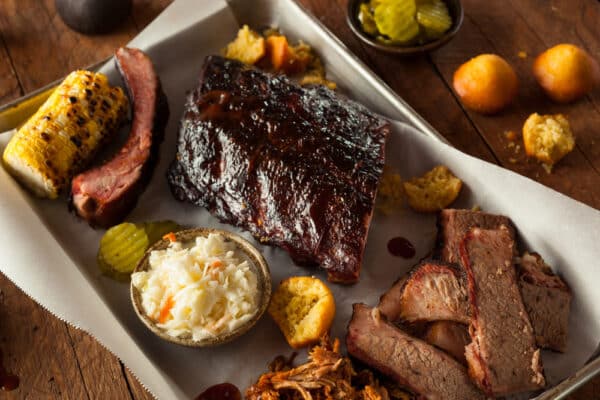
A meal of juicy smoked brisket
Carry-Over Cooking
Carry-over cooking refers to the phenomenon where food continues to cook after being removed from a heat source, due to residual heat trapped within the food.
For example, when a brisket is removed from the smoker, its internal temperature will continue to rise before it starts to cool down. This is because the heat from the outer layers of the steak slowly moves towards the center of the meat, causing it to cook a little more even though it is no longer in direct contact with the heat source.
If you decide to hold the meat in a dry cooler or rest it for several hours, carry-over cooking may continue for a few hours. Carry-over cooking can cause food to become overcooked if it is not taken into account when planning cooking times.
For this reason, pitmasters recommend removing the meat from the heat source a few degrees earlier than their target temperature and allowing it to rest before serving, to account for the extra cooking that will occur during the resting period.
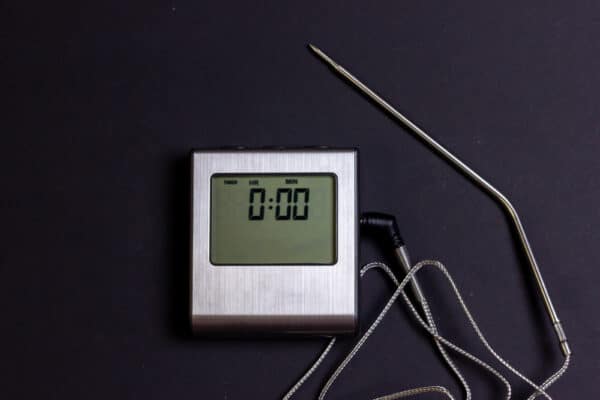
Meat Thermometer with Probe
When to Remove the Brisket from the Smoker
To achieve the perfect temperature of 203°F for brisket, it’s important to take it off the heat at around 190°F and let it rest for a bit.
This resting period can cause the meat to increase in temperature a little during carry-over cooking, so it’s better to remove it before it actually hits the ideal internal temperature.
The only way to be certain you’re reaching the correct internal temperature is by using an internal meat thermometer.
When it comes to resting your brisket, you have a few options.
If you plan to eat it within 1 or 2 hours after cooking, you can place it on a cutting board at room temperature.
However, if you’re cooking your brisket well in advance, you can rest it in a cooler, which is the faux Cambro method, or in a Cambro.
Cambros are another way to hold a brisket. Most Cambros look like mini-fridges, and some have heaters. If you don’t intend to eat the smoked brisket right away, this device will keep it warm for a long time.
Even though this is a good way to keep your brisket warm, it’s not considered resting.
How to Rest a Brisket
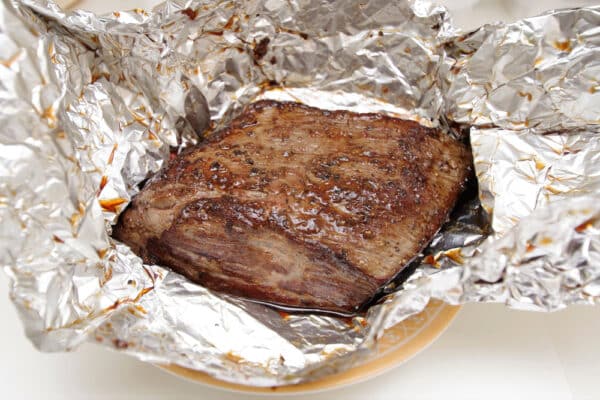
Resting brisket on foil to catch juices
Even though smoking brisket is challenging, resting is a straightforward process that takes little to no effort. Although there are different opinions about the finer details, here are the basics.
- Pull the brisket from the smoker once it’s reached 195°F
- Catch any juices or runoff from the brisket by placing it on a wooden cutting board or an aluminum pan. (Some choose to unwrap the brisket, while others wrap it for resting — we’ll discuss that later.)
How Long to Rest a Brisket
The meat should be left to rest for at least one hour, but preferably two hours, before slicing against the grain and serving it.
Should You Rest a Brisket Wrapped or Unwrapped?
Depending on the methods you use, your brisket may already be wrapped when you pull it off the smoker.
This is because something called “the stall” happens when you smoke a brisket. The meat reaches a certain temperature and struggles to go beyond it. Thus, it can take several hours longer to cook.
Pitmasters have come up with a way to overcome the issue of moisture loss when smoking brisket – the Texas Crutch.
The brisket is wrapped in butcher paper or foil and placed back in the smoker. This allows the temperature to continue rising and prevents moisture loss, leaving the brisket moist and tender.
Butcher Paper vs. Aluminum Foil
To improve your results, try substituting aluminum foil with butcher paper. Unlike aluminum foil, which conforms to the brisket and may cause over-steaming, butcher paper allows for better airflow and is more breathable.
Although it may be easier to use foil, using butcher paper is the way to go if you want to prevent over-steaming. If you’ve already tried this method, you might be wondering whether to keep the wrapping on or take it off before letting the brisket rest.
Wrapped vs. Unwrapped
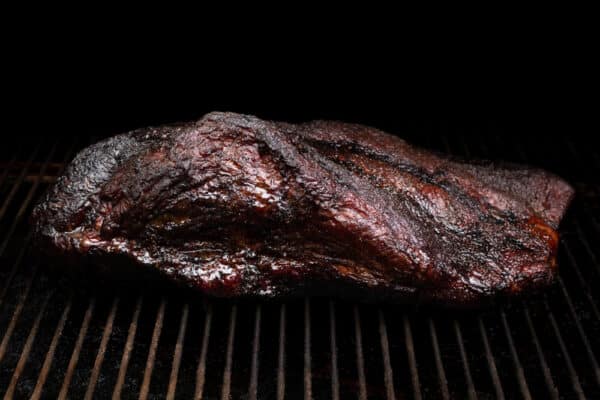
Resting Unwrapped Brisket
Unwrapped:
Like many pitmasters, I prefer to rest a brisket unwrapped to expose it to circulating air. To rest properly, the meat needs to be exposed to moving air. This is why you should always remove the wrapping from the brisket before you start the resting period, letting the meat sit at room temperature.
If you choose to keep the meat wrapped, there are two potential problems that may arise.
- Firstly, the meat may be overcooked due to the heat being trapped inside during carry-over cooking.
- Secondly, a significant amount of moisture may also be retained inside, which could damage the bark and make the brisket soggy. We want to maintain any bark that has formed on the beef’s surface.
If your brisket was wrapped due to the stall, remove the wrapping and place it in an aluminum tray to catch any juices.
This method is ideal when you’re serving right after resting time.
Wrapped:
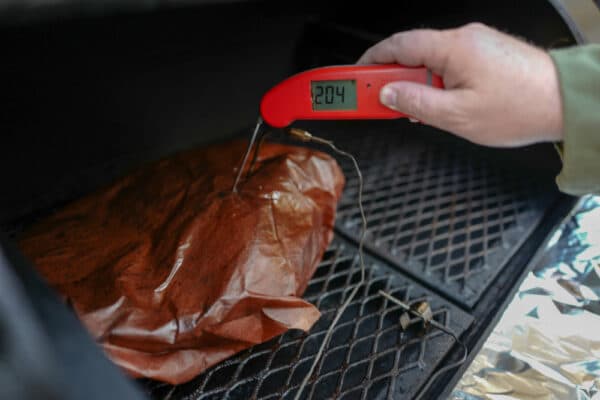
Resting brisket in Butcher’s Paper
The opposite opinion to rest a wrapped brisket is suitable for meat that you will hold for several hours before serving it because you will want to keep it warm.
If you want your brisket to stay moist and tender while holding it, make sure to wrap it in aluminum foil.
This will trap the moisture inside and help the meat retain its heat. Once you’ve taken it out of the smoker, keep it wrapped in foil and also wrap it in a towel.
Finally, place it in a dry insulated cooler for up to 4 hours. This allows the brisket to keep cooking and ensures that it stays juicy and tender.
Related Reading: See the best sides for brisket tacos here.
3 Ways to Hold or Rest a Brisket
1. Room Temperature
If the bark on your brisket isn’t set to your liking, letting it rest, unwrapped, at room temperature can help.
However, it’s important to note that you should not leave the brisket out for more than two hours, or it could become dangerous to eat.
Bacteria can start to grow if the internal temperature of the brisket drops below 140 degrees, which can cause food poisoning. So, it’s best not to let the brisket rest at room temperature overnight.

Resting a brisket at room temperature
2. Cooler or Faux Cambro
To keep the brisket warm for a longer period, pitmasters use an insulated cooler (Faux Cambro) that slows down the cooling process.
This ensures that the brisket remains at a safe temperature until it’s ready to be served.
To prevent the brisket from cooling down quickly, they pour hot water into the cooler and let it sit for half an hour.
Once the brisket is done smoking, they wrap it in foil and kitchen towels, and then place it in the warmed cooler with the lid closed.
To make sure your meat is cooked just right, keep checking the temperature inside the brisket with a thermometer probe. A well-stored brisket can stay hot for up to four hours.
Wait patiently and let it cool until the internal temperature reaches approximately 150°F, which is when it’s time to carve and serve.
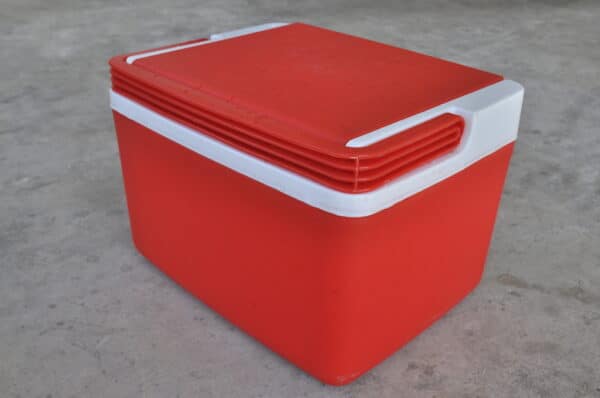
Insulated Cooler
3. Cambro
According to some grilling masters, the brisket tastes the most delicious when it’s kept in a Cambro for two to four hours.
However, some people complain about its impact on the bark, which may not remain as crispy after being wrapped in foil for such a long time.
But if you’re left with no other choice but to cook the brisket beforehand, this method is quite useful for keeping the meat warm.
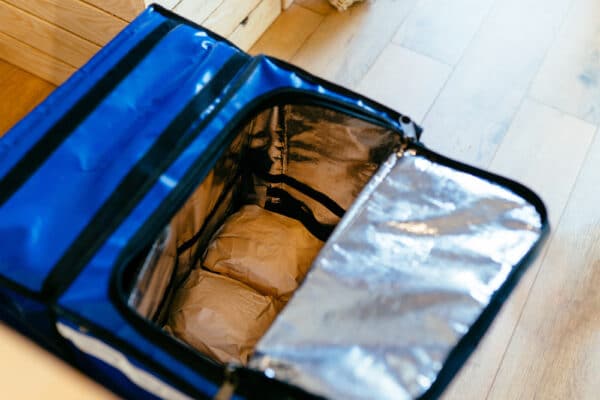
Cambro-like food warming box
Does Resting Brisket Soften the Bark?
If you wrap a brisket in foil while resting or holding it, the bark might become too soft due to the steam created by the foil.
However, you can counter this by returning the brisket to the heat to harden the bark.
Once the internal temperature of the brisket reaches 150°F, you can remove it from the foil. Don’t toss out the gravy, as you can pour it over the sliced meat.
For a crispy bark, you can put the meat back in the smoker or oven for 30 minutes at a low heat of 200°F to 220°F, making sure not to overdo it.
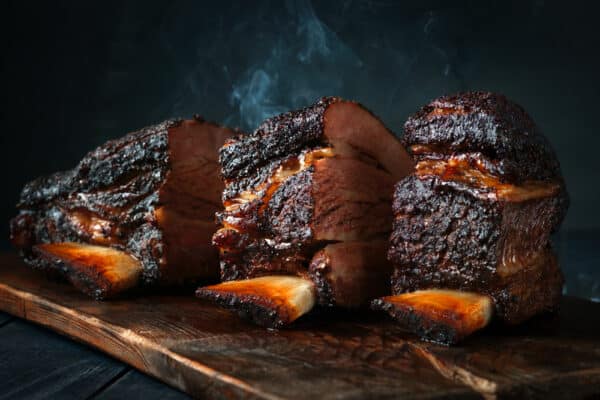
Crispy Bark
Summary
Step |
Description |
|
Resting |
The last stage of the cooking process. Once the brisket’s internal temperature reaches 190°F it should be allowed to rest and reabsorb moisture. |
|
Carry-over Cooking |
The brisket will continue to cook during the resting and holding process due to carryover cooking. |
|
Resting Time |
At least 30 minutes, but 1 to 2 hours is preferable. |
|
Wrapping |
Option 1: Let it rest unwrapped for serving immediately after resting. Option 2: Keep the brisket wrapped in foil or paper and vent one corner to allow steam to escape. |
|
Holding |
Wrap the brisket in foil and a towel and place it in a dry insulated cooler or Cambro for up to 4 hours to ensure it stays moist and tender for serving later. |
|
Temperature Tracking |
Use a thermometer to track the internal temperature of the meat and allow for carry-over cooking in your calculations. 190°F – Remove from the smoker 203°F – Temp to reach during carry-over cooking 150°F – End of rest and ready for slicing and serving 140°F and lower – Danger zone and food poisoning risk |
Conclusion
Smoking a brisket is a time-consuming process and one activity where patience is a virtue.
Yet, one or two hours resting is time well spent, and essential for bringing out the most flavor.
You can be sure your guests will want to know when you’ll do it again.
Checkout my review of the best 2-burner grills.
Frequently Asked Questions
Q: Can you rest a brisket at room temperature?
A: Yes, as long as you do not let the internal temperature of the brisket drop to 140°F or below. You want to slice it when the temperature reaches 150°F.
Q: How long should you let a brisket rest?
A: The amount of time required for resting a beef brisket is at least one hour, but preferably two hours. However, you should consider the size of the piece of meat and cut of meat, a whole packer will need more resting time than only the flat or point parts of the brisket.
Q: Can you reheat a rested brisket?
A: Yes, you can reheat a rested brisket in a preheated 250°F oven or your smoker. Unless you want to crisp up the bark, it’s best to wrap the brisket in foil. You should monitor the internal temperature to ensure you heat it through to about 165°F. Don’t reheat it for longer than 20 to 30 minutes to prevent it from drying out.
Q: Can I skip resting my brisket?
A: You can, but you shouldn’t. Brisket is rich in collagen, which dissolves during cooking. During the resting process, the brisket cools and the collagen firms up again and thickens the natural juices. And that is where the magic happens! If you can understand that resting is a crucial part of the cooking process, you’re ready to be a BBQ king.
Learn More About Grilling
If you want to learn more about grilling, check out these other helpful resources!

Kevin Turner
Hi there, I'm Kevin Turner, Founder and CEO of thegrillingmaster.com. I started this website to share my passion and knowledge with you. You can leverage my years of experience as a pit master and professional to grill great food!
About The Grilling Master
Hi there, I'm Kevin Turner, Founder and CEO of thegrillingmaster.com.
My passion has always been grilling, smoking and BBQ delicious meats that satisfy my inner carnivore!
I started this website to share my passion and knowledge with you, the hungry reader who wants to prepare the perfect meal.
You can leverage my years of experience as a pit master and professional.
Send me a message and let's connect on Twitter here.


